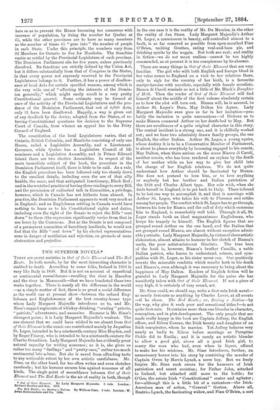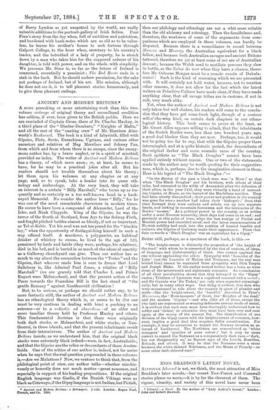TWO SUPERIOR NOVELS.*
'THERE are secret societies in Out of their Element and The Red Route. In both novels, by far the most interesting character is stabbed to death. According to some folks, Ireland in 1884 is very like Italy in 1848. But it is not on account of superficial or sentimental resemblances—recalling the river in Macedon and the river in Monmouth—that we have bracketed these two works together. There is nearly all the difference in the world —as a simple matter of fact, there is as great a social difference as the world can at present show—between the refined Eng- lishmen and Englishwomen of the best country-house type whom Lady Margaret Majendie introduces us to, and Mr. Sime's ragged regiments of whiskey-drinking, " orating " priests, -" patriots," adventurers, and assassins. Humour is Mr. Sime's strongest point ; it is Lady Margaret Majendie's weakest. The one element that we could have wished to see absent from Out of their Element is the comic one contributed mainly by Jaqueline St. Leger, intended to be a nineteenth-century Miss Hoyden, and by Roger Fitzroy, who is intended to be a nineteenth-century Sir Charles Grandison. Lady Margaret Majendie has evidently great natural capacity for writing nonsense ; as it is, she gives us rather too many " darlings " and "pretty ones," rather too much sentimental bric-a-brac. But she is saved from offending taste 'to any noticeable extent by her own artistic carefulness. Mr. Sime, on the other hand, far too often writes and even sketches carelessly; but his humour secures him against nonsense of all kinds. The single point of resemblance between Out of their Element and The Red Route is the air of reality in both, though • Out of their Element. By Lady Margaret Majendie. 8 volt:. London : Richard Bentley and Son. 1884.
The Red Route ; or, Saving a Nation. By William Slim. 3 vole. London : W. -Swan Sonnenechein and Co. 1884.
in the one case it is the reality of Mr. Da Maurier, in the other the reality of Jan Steen. Lady Margaret Majendie's Arthur St. Leger, a connoisseur in beauty, self-controlled almost to a fault, is as far removed as possible from open-mouthed Finn O'Brien, reciting Grattan, eating veal-and-ham pie, and drinking spirits by the noggin. But both are real ; and reality in fiction—we do not mean realism—cannot be too highly commended, as at present it is too conspicuous by its absence.
There are many things in Out of their Element that are very familiar. The girl who with both English and foreign blood in her veins comes to England on a visit to her relatives there, only to sigh for the country of her birth, is a favourite. martyr-heroine with novelists, especially with female novelists. Bianca di Caroli reminds us not a little of Mr. Black's Daughter of Heth. Then the reader of Out of their Element will find himself about the middle of the first volume absolutely certain as to how the plot will turn out. Bianca will, he is assured, be Arthur St. Leger's Dora, May Dalton his Agnes. Lady Margaret Majendie even goes so far in her imitation—pro- bably the imitation is quite unconscious—of Dickens as to make Bianca commend Arthur on her death-bed to May. But there are excellences of a quite original character in this story. The central incident is a strong one, and it is skilfully worked out; and we have two admirably drawn family groups, the one English, the other Italian. Arthur St. Leger, a young squire, whose destiny it is to be a Conservative Member of Parliament, is about to please everybody by becoming engaged to his cousin, May Dalton, when there arrives on the scene Bianca di Caroli, another cousin, who has been rendered an orphan by the death of her mother while on her way to give her child into the charge of her English relatives. We do not quite understand how Arthur should be fascinated by Bianca. She does not pretend to love him, or to love anything or anybody but her brother and Italian patriotism of the 1848 and Charles Albert type. Her sole wish, when she finds herself in England, is to get back to Italy. There is found to be but one way to accomplish it, and that is marriage with Arthur St. Leger, who takes his wife to Florence and settles among her people. The conflict which St. Leger has to go through, between his love for Bianca and the call of duty which summons him to England, is remarkably well told. Through it all, St. Leger stands forth an ideal magnanimous Englishman, who keeps his tragedy to himself. The English figures that are grouped round Arthur on the one hand, and the Italian that are grouped round Bianca, are almost without exception admir- able portraits. Lady Margaret Majendie, by virtue of sheer artistic elaboration, almost attains to humour in her sketch of Bianca's uncle, the poor artist-aristocrat Giacinto. The true hero• of the book is, however, Bianca's brother Camillo, a noble Italian patriot, who learns to understand, esteem, and sym- pathise with St. Leger, as his sister never can. One positively resents the miserable vendetta which results both in his death and Bianca's, even although it was necessary to bring about the happiness of May Dalton. Readers of English fiction will be grateful to Lady Margaret Majendie for the pains she has manifestly taken with Out of their Element. If not a piece of very high, it is certainly of very sound, art.
Mr. Sime could, we should say, write a first-rate Irish novel— as nearly first-rate as anything by Charles Lever, at all events —if he chose. The Red Route ; or, Saving a Nation—by the way, why give it such poor and sensational titles P—is not quite first-rate. It contains more than one blunder in character, conception, and in plot-development. The only people that are made really happy in the book are Captain Jeffrey; the English officer, and Eileen Conran, the Irish beauty and daughter of an Irish conspirator, whom he marries. Yet Jeffrey behaves very nearly as badly to Eileen before marriage as Peregrine Pickle did to Emilia ; and it is surely an artistic blunder to allow a good girl, above all a good Irish girl, to marry the man who had, even when in liquor, offered to make her his mistress. Mr. Sime introduces, further, an unnecessary horror into his story by contriving the murder of Captain Owen by Morris Lynch, a mere boy. But we freely forgive Mr. Sime such errors for the humours of Irish patriotism and secret societies ; for Father John, attached to Ireland, but attached still more to the bottle ; for O'Gee, the astute Irish " Constitutional " orator and agitator ; for—although this is a little bit of a caricature—the Irish- American man of action, " General " Gorton. Above all, Beatrice Lynch, the fascinating widow, and Finn O'Brien, a sort of Barry Lyndon as yet unspotted by the world, are really valuable additions to the portrait-gallery of Irish fiction. Poor Finn's story from the day when, full of ambition and patriotism, and burdened with bank-notes which are so old as to be value- less, he leaves his mother's house to seek fortune through Galport College, to the hour when, secretary to his country's deader, and the betrothed of a lady of property, he is struck down by a man who takes him for the supposed seducer of his daughter, is told with power, and on the whole, with simplicity. We presume Mr. Sime is, so far as the future of Ireland is concerned, essentially a pessimist ; The Red Route ends in a stab in the back. But he should eschew pessimism, for the sake not perhaps of Ireland, but of his art. His mission, although he does not see it, is to tell pleasant stories humorously, and to give them pleasant endings.

































 Previous page
Previous page